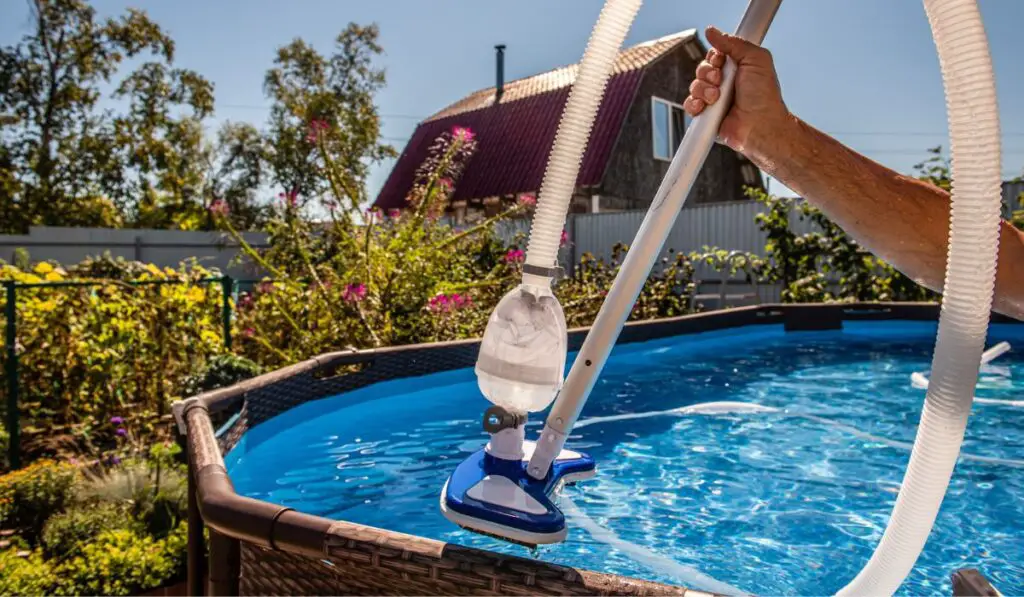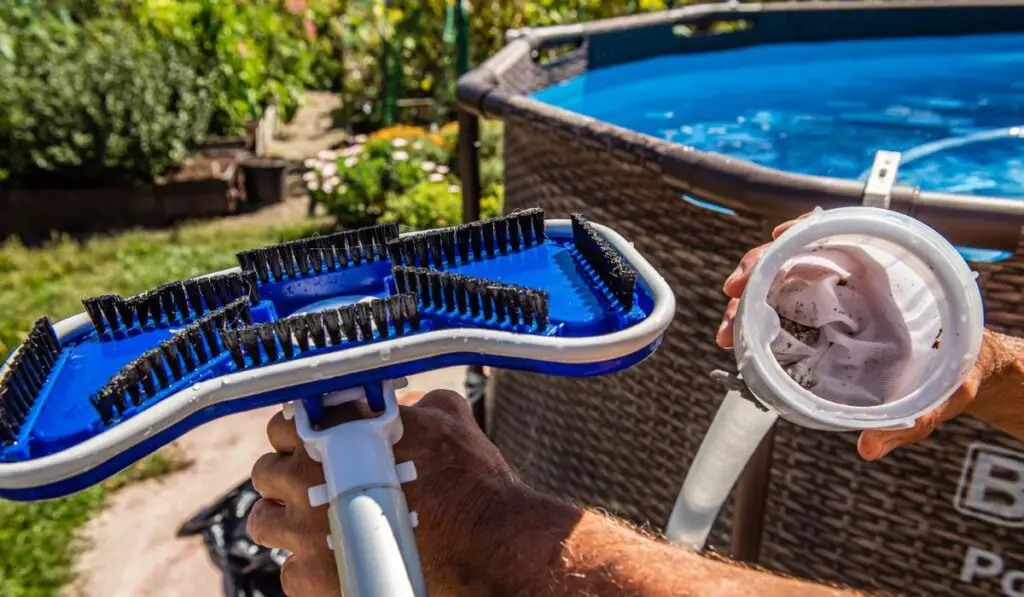Whether you’ve recently installed an above-ground pool or simply taken over the regular maintenance duties, you’ll need to vacuum it sooner or later. While the task can be challenging, it’s nothing compared to the trouble of rebalancing the water chemistry because you neglected to vacuum in the first place. So, how do you vacuum an above-ground pool?
Before vacuuming an above-ground pool, remove algae and other debris from the surface, clean the skimmer basket, and test the pump to see that the filter works. Then, assemble your vacuum equipment and prime the vacuum hose with water. When primed, route the pump to drain and vacuum the pool.
Remember: Failing to stay on top of your pool maintenance routine will quickly lead to debris building up on the bottom of your pool. What follows is likely a crazy growth of algae — and unless you’re an alligator, you don’t want to be swimming in slimy, green water. So, let’s take a closer look at how to safely (and thoroughly) vacuum your above-ground pool.
How Do You Vacuum an Above-Ground Pool?

Vacuuming your pool is a lot easier if you stick to a couple of rules, and here’s how experts recommend you do it:
Step 1: Remove Surface Debris, Then Test the Filter
Use a leaf rake or skimmer (on Amazon) to remove leaves and surface debris from your pool. Next, clean the skimmer basket and turn on the pump to see if water runs through the filter.
Step 2: Connect the Vacuum Head to the Extension Pole
Connect the swivel end of your vacuum hose to the vacuum head, then connect the head to an extension pole. Gently lower the vacuum head to the bottom of the pool, leaning the pole against the side of the pool close to the water return outlet.
Step 3: Prime the Vacuum Hose
Hold the free end of the vacuum hose near the water return outlet to fill it with water and expel air. Keep a hand on the pole to prevent the vacuum head from floating to the surface. Continue priming until you’ve filled the hose completely and no air bubbles come from the vacuum head.
Step 4: Connect the Skimmer Disc and Initiate the Vacuum
Pull the hose away from the water return outlet and attach the skimmer disc to the skimmer on top of the suction port. Some vacuums require you to plug the hose end directly to the suction port. Ensure the hose end doesn’t get out of the water all this time, or it will let in too much air.
Step 5: Vacuum the Pool Bottom Uniformly
Stand where you can see the pool bottom clearly, then carefully move the vacuum head back and forth over the bottom of the pool to avoid kicking up debris. As you pass the vacuum head, be sure to overlap the previous path slightly. Continue vacuuming until you’re satisfied the pool bottom is clean.
It’s important you keep an eye on the filter pressure gauge and turn off the pump if you notice the pressure reading is 10 PSI above the initial reading.
Backwash your filter before you can go ahead with the vacuuming. When you’re done, clean the skimmer basket and store the parts safely.
What Equipment is Needed?
Compared to other pool maintenance routines like cleaning your filters or closing the pool, vacuuming doesn’t need a dozen pieces of equipment. These are the things you need for the task:
- Vacuum hose (on Amazon)
- Vacuum head (on Amazon)
- Pool skimmer disc or leaf rake
- Backwash hose
- Extension pole
- Filter system with multiple port valve head
Note that most of this is usually available in a simple pool vacuuming kit like this one (on Amazon).
What Setting to Put Your Pool Pump On
If the pool has light to moderate sediment levels, leave the filter valve setting in the ‘Filter‘ position. This way, dirty vacuum water will run through the pool filter to get rid of contaminants, while filtered water gets through the return lines back to the pool. The overall water level won’t change much.
However, if the pool is contaminated with lots of sediment, such as after an acute algae bloom, set the multiport filter valve to ‘Waste‘ or ‘Drain.’ It’s the only sure way to bypass the filter and direct the contaminated water to an external drain for disposal.
This comes in handy to prevent clogging your filter with sediment. Be sure to pump in more fresh water to restore the normal water level because you always discharge water down the drain when vacuuming to ‘Waste.’
How to Vacuum on the Waste Setting
Vacuuming on ‘Waste‘ is only possible if your filter system is controlled by a multiport valve, like in a sand filter. You only want to use this setting if your pool has a lot of debris and small particles like dead algae that you can’t let through your filter.
Here’s how to vacuum safely on the ‘Waste‘ setting:
Step 1: Fill Up the Pool
Since vacuuming on the ‘Waste‘ setting will lower the water level, you need to fill the pool simultaneously. And if the water level goes below the skimmer, you’ll need to stop and refill before continuing.
Position your garden hose in the stream of fresh water such that it won’t stir up the dirt you’re planning to remove. You also need to turn off any heater or pool cleaner.
Step 2: Prepare the Pool Vacuum
Attach the pole and swivel end of your vacuum hose to the vacuum head, then gently lower the head into the pool. Prime the vacuum hose with water and connect its other end to the skimmer vac plate. Next, seat the vacuum plate securely over your skimmer basket.
Step 3: Clean Your Pump Basket
Clean out the pump basket (hair and lint pot) to allow more efficient suction. Remember, no water is circulating when vacuuming on the ‘Waste‘ setting, so you need all the suction you can get.
Step 4: Change the Filter Setting to ‘Waste’
Turn off the pool pump and put the filter dial in the ‘Waste‘ position once your vacuum parts are all set. Turn the pump on and closely monitor the process as your pool begins to empty.
When debris has built up in the skimmer basket, you’ll notice a decrease in the suction. If that’s the case, turn off the pump and clean everything. If you have a bottom drain, close it as well.
Step 5: Start the Vacuuming
Start vacuuming on the shallow end, all while monitoring the water level. Remember, letting it get too low will cause your pump to run dry and get some severe damage.
If you’re done vacuuming and need to add more water, turn off the pump and disconnect all vacuum equipment. You also need to clean out the pump basket. You can restore the pump setting to ‘Filter‘ and run it once the water level is back up.
What to Know Before Vacuuming
You could damage the delicate vinyl layer of your pool if you don’t prepare well for the vacuuming process. Here’s what to know before you get to the task:
Keep in Mind How Your Pool Is Constructed
Your above-ground pool has tampered-down sand that’s lined with vinyl, and the sand usually shifts as people use the pool.
This may create spaces under the liner that could easily get punctured by vacuum equipment. Therefore, vacuum gently so you don’t put too much downward pressure on the vacuum head.
Brush the Pool Walls
Brush the walls of your pool to remove algae, dirt, and other debris while keeping an eye on the water line. Let the debris rest at the bottom of the pool before you vacuum.
Thoroughly Clean Your Pool Equipment

Clean debris from your skimmers, pump strainer basket, pool filter, and hoses. Don’t forget to remove any Gizmos that protect the skimmer from ice damage. Cleaning out all these parts ensures maximum suction at the point where your vacuum head meets the pool liner.
Fill the Pool Halfway Above the Skimmer Opening
Once you remove your pool cover, the water level will often get low to the point you can’t run the filtration system. So, fill it back up before you can vacuum the pool effectively.
Experts recommend you fill the pool halfway above the skimmer opening. Other people also fill it to 1” below the top of the skimmer opening, and it works just fine.
